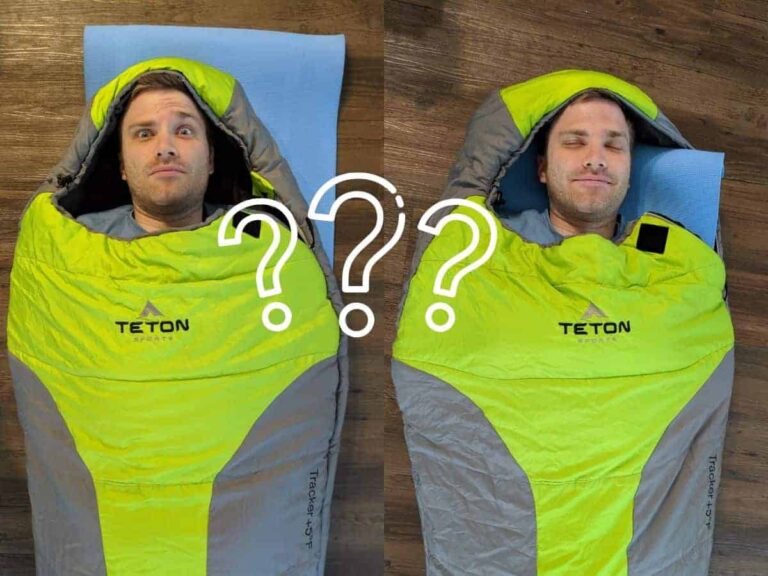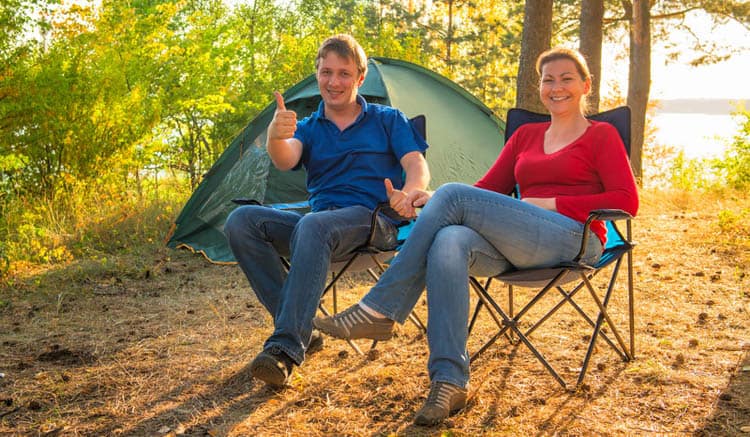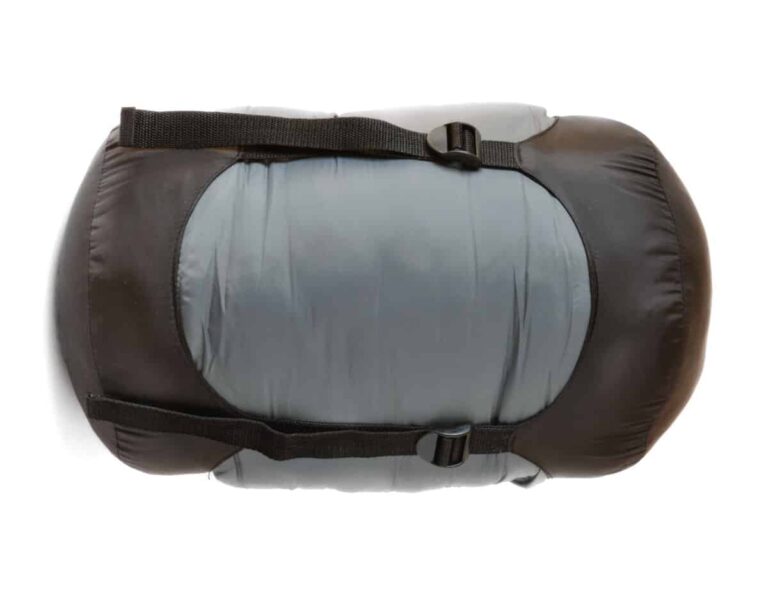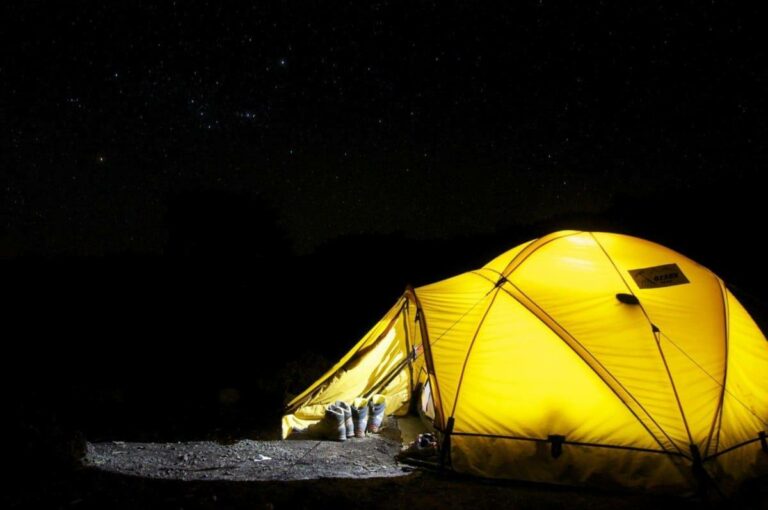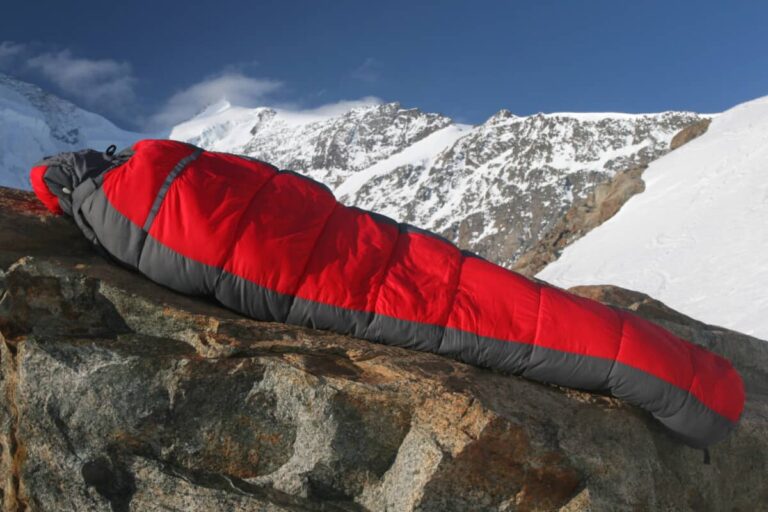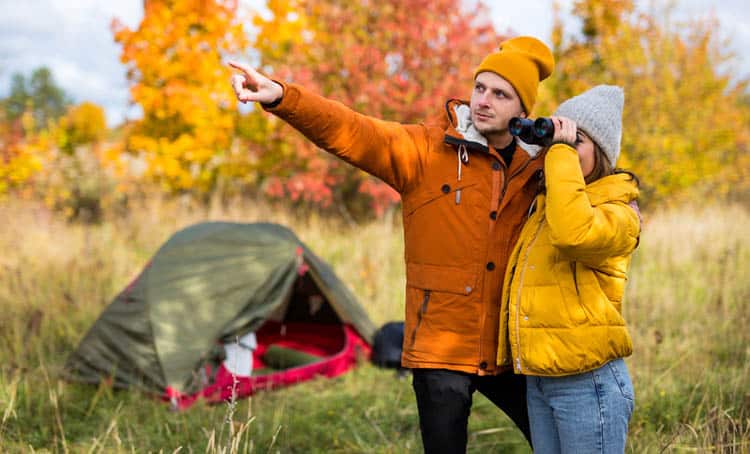How To Keep Your Dog Warm When Camping In The Cold
Your canine companion may have fur to keep them warm, but they might still need a little help staying warm sometimes.
Camping is fun for the whole family, including four-legged friends like the family dog. Not only is time outside great for dogs, but they tend to love getting out into nature as well. Even as the weather gets colder, many dogs will happily join in on a camping trip.

However, things can get a little tricky when it comes to keeping your dog warm. Most humans have at least a basic idea about how to keep other humans warm – even if they are of different ages or sizes. On the other hand, it’s not always clear how much effort should be put into keeping a dog warm. After all, they have fur for that!
Truthfully, no matter how much fur your dog has, they will have a limit as to how much cold they can handle. Understanding the unique needs of your dog is crucial for keeping them happy and healthy in the cold outdoors. To help you to ensure your dog has the best experience while cold-weather camping, I’ve sought out a variety of methods you can use to protect your canine friend from the cold.
Read on, and learn what you need to know about how well your dog will do in the cold, tips for keeping them warm, and what cold-related health problems to look out for.
12 Tips For Keeping Your Dog Warm While Camping In The Cold
Although they are covered in fur, dogs sometimes need a little help with staying warm! Before taking your dog out on a colder camping trip, consider using the following tips to keep your dog warm and cozy.
Consider The Breed
There are so many dog breeds out there – large, small, fluffy, and sleek. You may have heard that some breeds were created to take on certain jobs. Many dog breeds have also developed with a certain climate in mind.
If you’re planning to camp in cooler weather, take a close look at your dog. Their appearance can tell you a lot about whether they are more suited to hot weather or cold weather. Dogs with longer, thicker coats like huskies, malamutes, and the Great Pyrenees tend to thrive at cold temperatures. These dogs are built for snowy climates and can have a more difficult time in hot weather.
When it comes to dogs that are built for the heat, things can get a little bit more complicated. Shorter coats can be a great indicator that a dog will handle heat better. That said, breeds like labradors and Australian cattle dogs may not appear as obviously adapted to the heat, but they handle it quite well. That tends to mean you’ll need to be more careful with these dogs while you’re camping in the cold.
Smaller dogs like chihuahuas can have a particularly tough time in the cold. They often have thinner coats and less fat to keep them warm.
If you have a dog that is less suited to cold weather, it doesn’t mean you can’t bring them on your camping trip. As long as you have all the essentials they need to get warm, you can still bring your four-legged friends with you on your camping excursions.
With so many different breeds out there, how do you know which ones are more suited for camping? Learn more about the dog breeds that are more intelligent, suitable, and capable of handling a variety of weather conditions in our article on the topic here.
Keep Them Dry
Most of us know that the experience of being cold and wet is far worse than just being cold. Leaving home with wet hair on a cold morning can be an uncomfortable feeling. Just imagine experiencing that feeling throughout your entire body – that’s the life of a dog.
Wet fur can really decrease your dog’s ability to stay warm. It’s easier to stay warm in a dry coat than a wet one. Avoid leaving your dog out in the rain without shelter. If your pup decides to go for a swim, make sure they get dried off as quickly and thoroughly as possible after.
Protect Their Paws
Booties are another tool you can use to keep your dog a bit more comfortable in the cold. Dog booties are specifically designed to protect their paws when they’re out and about in cold weather. If you’ve ever seen one of those videos of a dog begging to go outside, only to immediately turn around as soon as they realize the ground is cold and wet, then you’re sure to understand how a pair of booties can be useful.
Ranging from essentially functioning as socks to a full set of boots with gripping abilities, dog booties can work in a variety of situations. In addition to keeping your dog warmer and more comfortable, they are also a great way to avoid dirty paws sharing your bed at night.
If you decide to try out a pair of dog booties, make sure to give them plenty of time at home to get used to the feeling. Most dogs will be uncomfortable with the sense of something on their paws if they haven’t worn something similar before.
Bundle Them Up
When we need to keep warm, we layer up. Sometimes that means adding blankets to our beds, and sometimes it means putting on sweaters, coats, and other warm clothing.
Although many dogs may not need as many of these layers as we do, you can use the same tactics to keep your dog warm while camping in the cold. To begin with, make sure they have plenty of blankets anywhere they might choose to lay down.
Although not for every dog or for every dog owner, outside of resting time, dog coats and boots (Ruffwear.com) can be helpful. Both of these tools can be found in different sizes and thicknesses so you can change up the style depending on the climate.
Let Them Sleep With You
Not everyone allows their dog to sleep with them at home. It’s a personal choice that doesn’t often have a negative effect on the dog. Dogs that live inside typically have plenty of shelter and warmth to be comfortable, even if they aren’t in bed with their human family.
However, it might be a good idea to change the rules when you’re camping in the cold. Sharing body heat with your canine friend is a great way to keep you both warmer while you sleep. Body heat is free, and if you are unnerved by sleeping outside in a tent, you might actually sleep better with your dog.
If you’re concerned about them getting your camping bed dirty, you can clean off their paws before bed, give them some booties during the day, or equip your bed with a blanket meant for your dog to use. However you choose to go about it, your dog will be grateful for the extra warmth.
Get Some Dog Pajamas
You might be opposed to the idea of dog pajamas, but just pause for a bit and consider.
While they may not typically be needed, pajamas for dogs can be very beneficial in a cold environment. Just like with humans, the added clothing can help them to maintain warmth throughout the night. Unlike blankets, pajamas can be trusted to keep your pup covered and warm no matter how they might shift around.
If you’re interested in getting your dog a pair of pajamas, keep in mind that you’ll have to spend some time letting your pup get used to wearing them. Opting for snaps or buttons can help to keep your dog more comfortable, as zippers can get caught on their fur.
Finally, be careful to avoid any kind of dog clothing if your pet sleeps in a wire crate. Otherwise, there can be risks of snags due to the clothing getting caught on corners or wiring.
Make Them A Warm Bed
Whether you plan to allow your dog to sleep with you at night or not, they’re going to need somewhere to go while resting. Giving your dog a place to sleep can not only provide warmth but also allows dogs to stay a bit cleaner. That way, you won’t have a filthy pooch crawling into bed with you at night.
There are a lot of options out there when it comes to pet beds. If you prefer to keep it simple, a basic bed with a blanket or two can be a good option. In wetter climates, you may want to give them some shelter to stay dry. Pop-up tents, a covered kennel, or even a suitably-sized carrier can keep your pup nice and dry.
Keep Them Well-Fed And Hydrated
Staying warm requires more effort and therefore more calories. Because of that, your dog will likely need more food than usual. Don’t be afraid to feed them more during this time. The combination of cold weather and extra exercise will balance out the larger portions.
Additionally, hydration is key to making sure your dog has enough energy to stay warm. While water might not provide the calories needed to keep your pet warm, it keeps their body working effectively so that they can use calories from their food as efficiently as possible.
Get Active
We’re all familiar with the feeling of getting warmer as we move around more. According to Livestrong.com, this is because the process of generating energy in the body also creates heat. Not only is exercise good for your muscles and heart, it can also help to warm you up when you’re in a cold climate.
The same is true for your dog. Keeping them up and moving will help them to stay warmer. Additionally, dogs won’t be left covered in cold sweat afterward because they don’t experience full-body sweating the way that humans do. So whether it’s a game of fetch or going for a hike, your dog can really benefit from getting some exercise in.
Try A Pet-Sized Sleeping Bag
Blankets are great, but they may not always be quite enough for cold temperatures. If you’re planning on taking your pup camping when the climate may reach under 50 degrees, it may be worth looking into a sleeping bag or another sleeping situation where you can capture your dog’s body heat.
Sleeping bags are effective because they capture body heat and reflect it back. This can be achieved with a sleeping bag that encircles the body, or with a warm sleeping pad and a blanket.
You can get these kinds of sleeping bags made for pets (check out this on Amazon).
Bring A Portable Heater
Even in the warmest of sleeping bags, the nighttime hours can sometimes get a bit too cold for both humans and dogs. Bringing along a portable heater is a great way to temporarily warm up the tent to keep everyone warmer and happier.
Portable heaters can be used outside as a way to warm up the space near you and your dog. Tent heaters can be used indoors with caution and should never be used while sleeping. But if you’re interested in finding the best tent heater, I’ve actually tested several extensively, make sure to find my top pick, here.
When used in an enclosed space, heaters can easily become dangerous. To learn more about how to use a heater in your tent safely, take a look at our article on the topic here.
Use Your Body Heat (Embrace the Cuddle)
I’ve mentioned previously how beneficial body heat is for keeping your dog warm. Aside from snuggling up with your dog in bed, it’s also a good idea to let them share your body heat throughout the day. Whenever you’re relaxing around the fire, take some time to share some warmth with your pup!
Smaller dogs can spend some time in your lap, while large dogs can be right next to you and get a lot of benefit. However you like to cuddle your pup, they’re sure to appreciate the warmth and affection.
How Cold Is Too Cold For Camping With My Dog?
According to PetMD, 45 degrees is the temperature at which you should start keeping an eye out for signs of discomfort in your dog. At that point, dogs that are more sensitive to cold temperatures may begin to let you know they aren’t having a great time outside anymore. That said, most larger dogs and those with normal or thicker coats will likely be okay.
At 32 degrees, more dogs are likely to start shivering. Unless you have a dog that is adapted to cold weather, it’s a good idea to keep them inside and give them plenty of opportunities to get warm. If your dog is smaller or is doesn’t have a thick coat, it’s best to keep time spent outside to a minimum.
No matter what kind of dog you have, it’s time to prioritize warmth once the temperature sinks to 20 degrees. Dogs like huskies and malamutes are likely to be okay outside for shorter periods of time, but other breeds will benefit from any added insulations with coats and booties just to make a trip out for bathroom time.
Hypothermia can occur in dogs at any of the temperatures I’ve discussed. It all depends upon the size of the dog, the thickness of its coat, and how long they’ve spent outside. Consequently, it’s incredibly important to keep a close eye on your dog even when it seems to be just a little chilly outside.
It’s one thing to determine whether or not it’s too cold to take your dog camping, but another thing entirely to decide if it’s too cold to camp at all! Because everyone has different temperature preferences, we’ve gathered insight from experienced campers about the conditions they’re willing to camp in – and when it’s just too cold! Find out how they responded in our article here.
Can Dogs Sleep Outside When Camping?
Technically speaking, yes. Dogs can sleep outside while you’re camping. However, it may not be the best idea to leave your canine companion outside at night.
To begin with, the area is unfamiliar. While your dog is outside at home, they are likely protected by a fence. As a result, they are less likely to get very far if they decide to chase after a squirrel, cat, or other intruding animals.
Meanwhile, dogs left outside camping may be able to escape their collar or break a rope meant to keep them in the campsite. If your dog decides to take off after an animal, they may end up lost in the woods or injured.
Secondly, a dog can ease the mental stress that comes from sleeping in a tent (especially if you’re by yourself). It can be very comforting to be with your dog even if they aren’t of the guard dog variety.
Tents don’t really protect you much from wild animals (besides snakes), but that’s okay since being attacked by a wild animal while you’re in a tent is incredibly rare (see our article on the subject if you want to see stats.)
Finally, it’s a lot easier to keep your dog warm inside. Even if they aren’t cuddling up with you in bed, the shelter itself can really be helpful for protecting your pet from wind, rain, or snow. Additionally, the bedding kept inside a tent or RV has a much better chance of staying cleaner than those left outside.
How Can I Tell If My Dog Is Cold?
Your dog may be covered in fur, but he’s still at risk of issues like frostbite and hypothermia while outside at cold temperatures. Generally speaking, you’ll probably start feeling the effects of cold weather before your dog will – but this may not always be the case. Smaller dogs and those with thinner fur may have a harder time keeping warm.
Because there can be so much variety between the breeds, it’s important to stay alert. Watch for signs that your dog may be starting to succumb to the cold.
According to the Ontario SPCA, cold dogs will exhibit the following signs:
- Lifting paws to avoid touching the ground.
- Shivering.
- Vocalizing.
- Making themselves smaller through a hunched posture.
- Shifting from happily playing to becoming anxious or upset.
It’s best to get your pet warmed up before seeing these signs, or at least when you first begin noticing them. Prolonged exposure can lead to more serious conditions.
What if your dog shivers even when it isn’t freezing outside? It could be a sign that they are anxious rather than cold. Learn more about how to camp with an anxious dog in our article on the topic here.
If you see any of the following symptoms, your pet may be experiencing hypothermia or frostbite:
- Pale or red skin.
- Blisters.
- Weakness.
- Confusion.
- Shallow breaths.
- Becoming unconscious.
When these symptoms are present, your best option is to get your furry companion to a vet as quickly as possible. They will have the best strategies for warming your pet up and getting them back into a healthy state.
